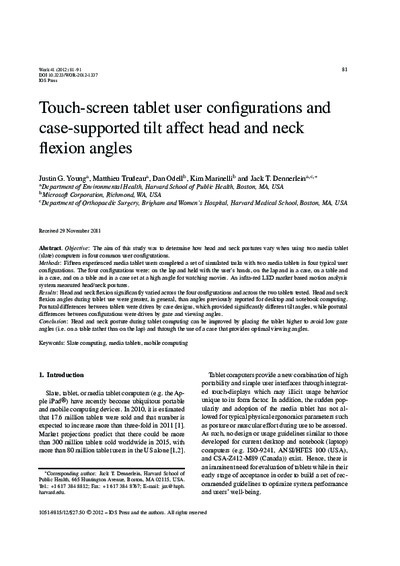 Diese Seite wurde seit 5 Jahren inhaltlich nicht mehr aktualisiert.
Unter Umständen ist sie nicht mehr aktuell.
Diese Seite wurde seit 5 Jahren inhaltlich nicht mehr aktualisiert.
Unter Umständen ist sie nicht mehr aktuell.
 Zusammenfassungen
Zusammenfassungen
Objective: The aim of this study was to determine how head and neck postures vary when using two media tablet (slate) computers in four common user configurations.
Methods: Fifteen experienced media tablet users completed a set of simulated tasks with two media tablets in four typical user configurations. The four configurations were: on the lap and held with the user's hands, on the lap and in a case, on a table and in a case, and on a table and in a case set at a high angle for watching movies. An infra-red LED marker based motion analysis system measured head/neck postures.
Results: Head and neck flexion significantly varied across the four configurations and across the two tablets tested. Head and neck flexion angles during tablet use were greater, in general, than angles previously reported for desktop and notebook computing. Postural differences between tablets were driven by case designs, which provided significantly different tilt angles, while postural differences between configurations were driven by gaze and viewing angles.
Conclusion: Head and neck posture during tablet computing can be improved by placing the tablet higher to avoid low gaze angles (i.e. on a table rather than on the lap) and through the use of a case that provides optimal viewing angles.
 Dieser wissenschaftliche Zeitschriftenartikel erwähnt ...
Dieser wissenschaftliche Zeitschriftenartikel erwähnt ...
 Dieser wissenschaftliche Zeitschriftenartikel erwähnt vermutlich nicht ...
Dieser wissenschaftliche Zeitschriftenartikel erwähnt vermutlich nicht ... 
 Nicht erwähnte Begriffe | Ein Notebook pro StudentIn (ENpS), iPad, Notebooks an Schulen, Tablets in education |
 Zitationsgraph
Zitationsgraph
 Zitationsgraph (Beta-Test mit vis.js)
Zitationsgraph (Beta-Test mit vis.js)
 2 Erwähnungen
2 Erwähnungen 
- Tablet-Nacken: Kinder besonders gefährdet (2013)


- Usage pédagogique des tablettes tactiles numériques - une étude de cas en enseignement primaire genevois (Loïc Boijol) (2014)


 Anderswo finden
Anderswo finden
 Volltext dieses Dokuments
Volltext dieses Dokuments
 |  Touch-screen tablet user configurations and case-supported tilt affect head and neck flexion angles: Artikel als Volltext ( Touch-screen tablet user configurations and case-supported tilt affect head and neck flexion angles: Artikel als Volltext ( : :  , 1127 kByte; , 1127 kByte;  : :  2021-03-21) 2021-03-21) |
 Anderswo suchen
Anderswo suchen 
 Beat und dieser wissenschaftliche Zeitschriftenartikel
Beat und dieser wissenschaftliche Zeitschriftenartikel
Beat hat Dieser wissenschaftliche Zeitschriftenartikel während seiner Zeit am Institut für Medien und Schule (IMS) ins Biblionetz aufgenommen. Beat besitzt kein physisches, aber ein digitales Exemplar. Eine digitale Version ist auf dem Internet verfügbar (s.o.). Aufgrund der wenigen Einträge im Biblionetz scheint er es nicht wirklich gelesen zu haben. Es gibt bisher auch nur wenige Objekte im Biblionetz, die dieses Werk zitieren.











 Gesundheit
Gesundheit Notebook
Notebook Tablet
Tablet
 Biblionetz-History
Biblionetz-History